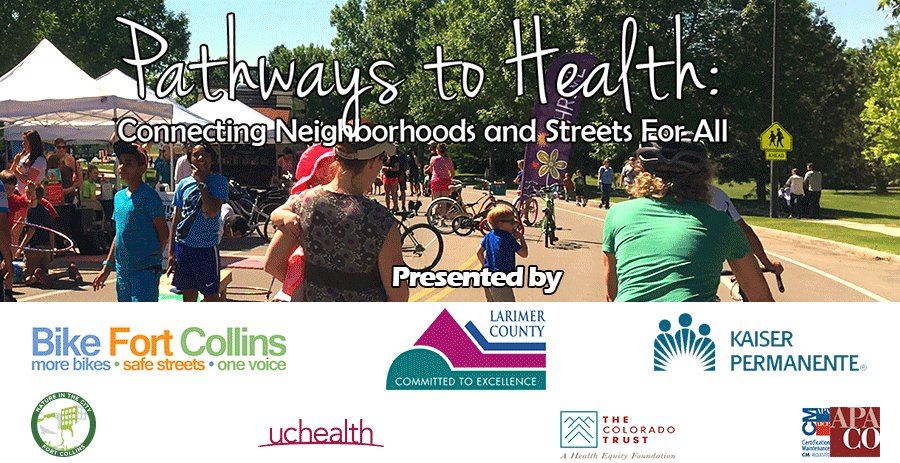On March 23rd at The Ranch Events Complex, Bike Fort Collins in partnership with Kaiser Permanente and the Larimer County Department of Health and Environment hosted the Pathways to Health: Connecting Neighborhoods and Streets For All Summit. It was a great event where over 100 Northern Colorado public health professionals, planners and advocates convened to learn about the connections between the built environment and health/transportation equity.
Background
Our physical environment comprises both built and natural space, places where we live, work, and play. The design of these places as well as their accessibility through a variety of transportation modes – or lack thereof – can influence the health and well-being of our communities as well as individual behaviors related to healthy eating and physical activity.
Unfortunately, inequalities are rooted in how our communities were and, in some cases, continue to be, designed, funded, and maintained leading to health disparities. The dramatic growth and associated affordability challenges in Northern Colorado threaten to exacerbate existing inequities.
As planning and design have such a profound impact on the health and wellness of communities, practitioners ought to carefully weigh and consider the expressed needs of the people living in them, particularly vulnerable and historically marginalized people, when making decisions. An understanding of the root causes of inequities in our communities, their relationship to planning and design, what’s at stake, and how to work together can help build a fairer and more equitable future for our region.
Summit Description
A healthy community is one that addresses health through all policies and embraces inclusive community engagement to promote physical activity and mental and social well-being. This summit explored how planning with a lens for health can create vibrant communities that are engaged, healthy, and inclusive. We sought sessions that challenged participants to understand systemic shortcomings and inspired them to take action to promote a healthier community through toolkits, example programs and policies, and partnerships.
By the end of the Summit attendees understood the following:
- Aspects of the built environment that promote and hinder positive community health outcomes.
- The historical context and systemic shortfalls that contribute to health disparities and relevant tools and best practices to address them.
- How to incorporate data and/or community engagement into built environment projects and why these are integral for success.
Featured Speakers
The program featured keynote speaker Dr. Richard Jackson as well as a series of breakout sessions intended to “drill down” to more specific topics around transportation and health equity.
The program also included a closing panel, titled: Reflective Community Engagement as a Pathway to Change in its Entirety
What if we approached community engagement as a learning practice rather than something required to check off or get though for a project? What if we, as practitioners and built environment professionals, approached our work and practices by asking rigorous questions of ourselves? How does curiosity shape our cultural competency? These are the kinds of questions that the panelists use to frame their work with and in communities, particularly vulnerable communities –i.e. youth, elders, POC, LGBTQX, people with different physical abilities, immigrants, etc. They speak to their work as well as weave in examples of successful community engagement models and/or practices.

